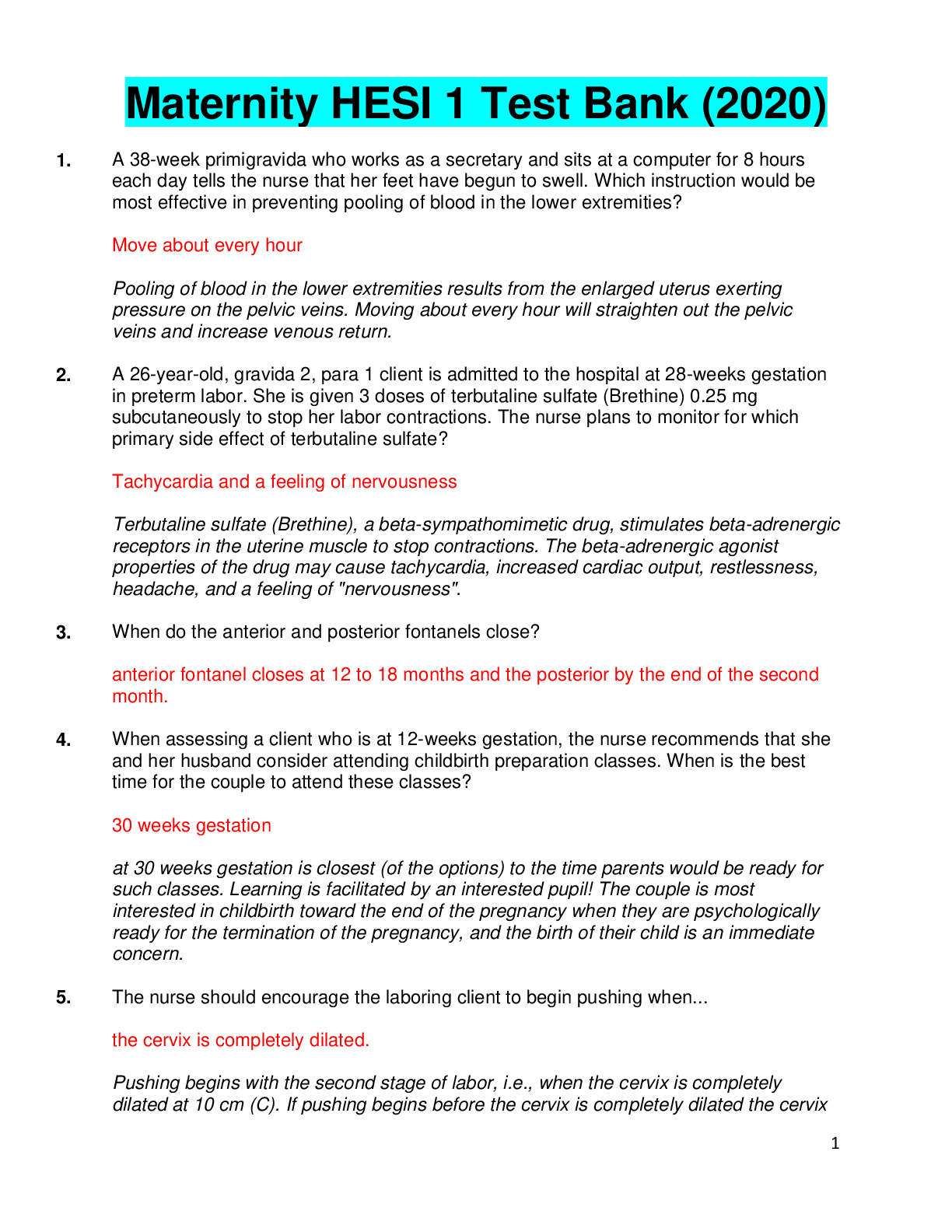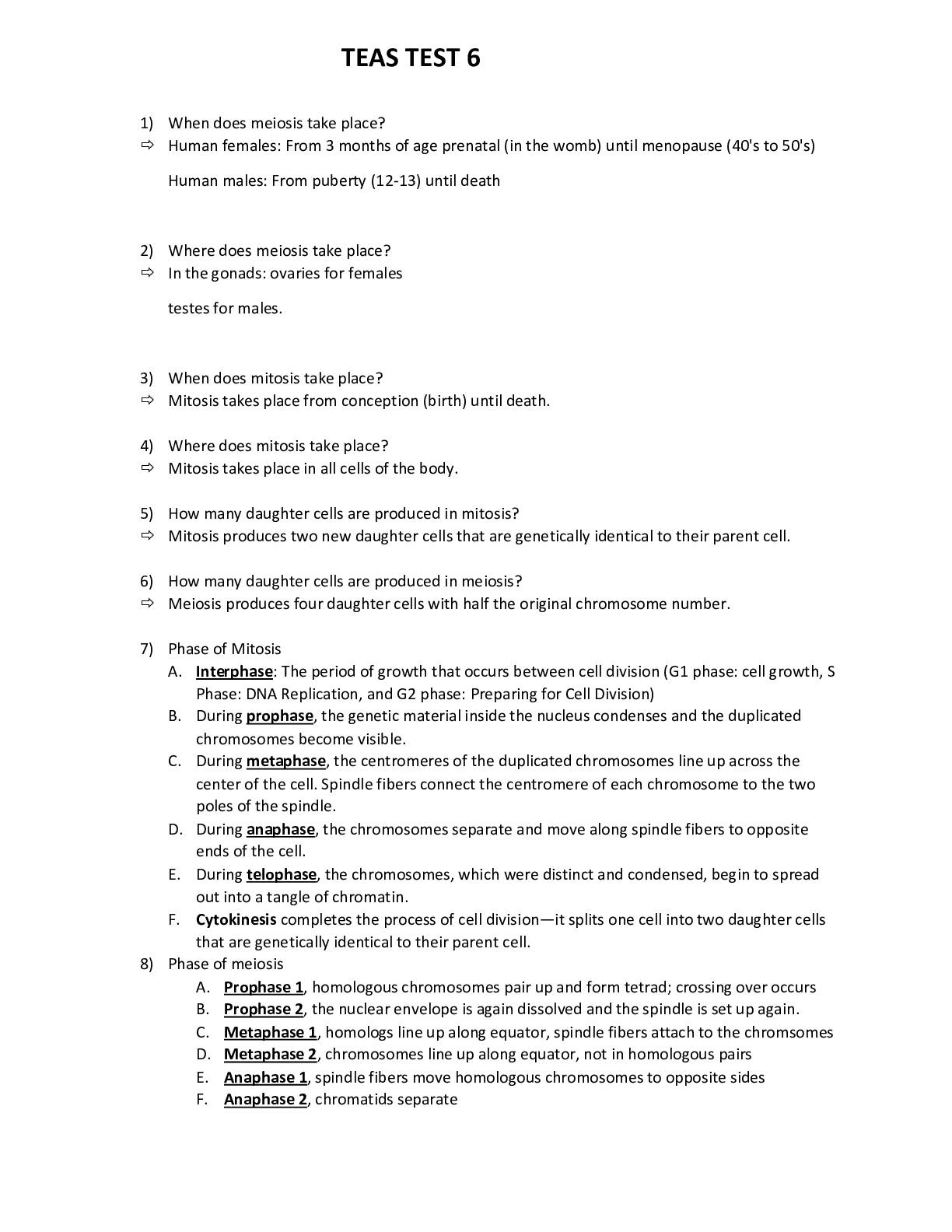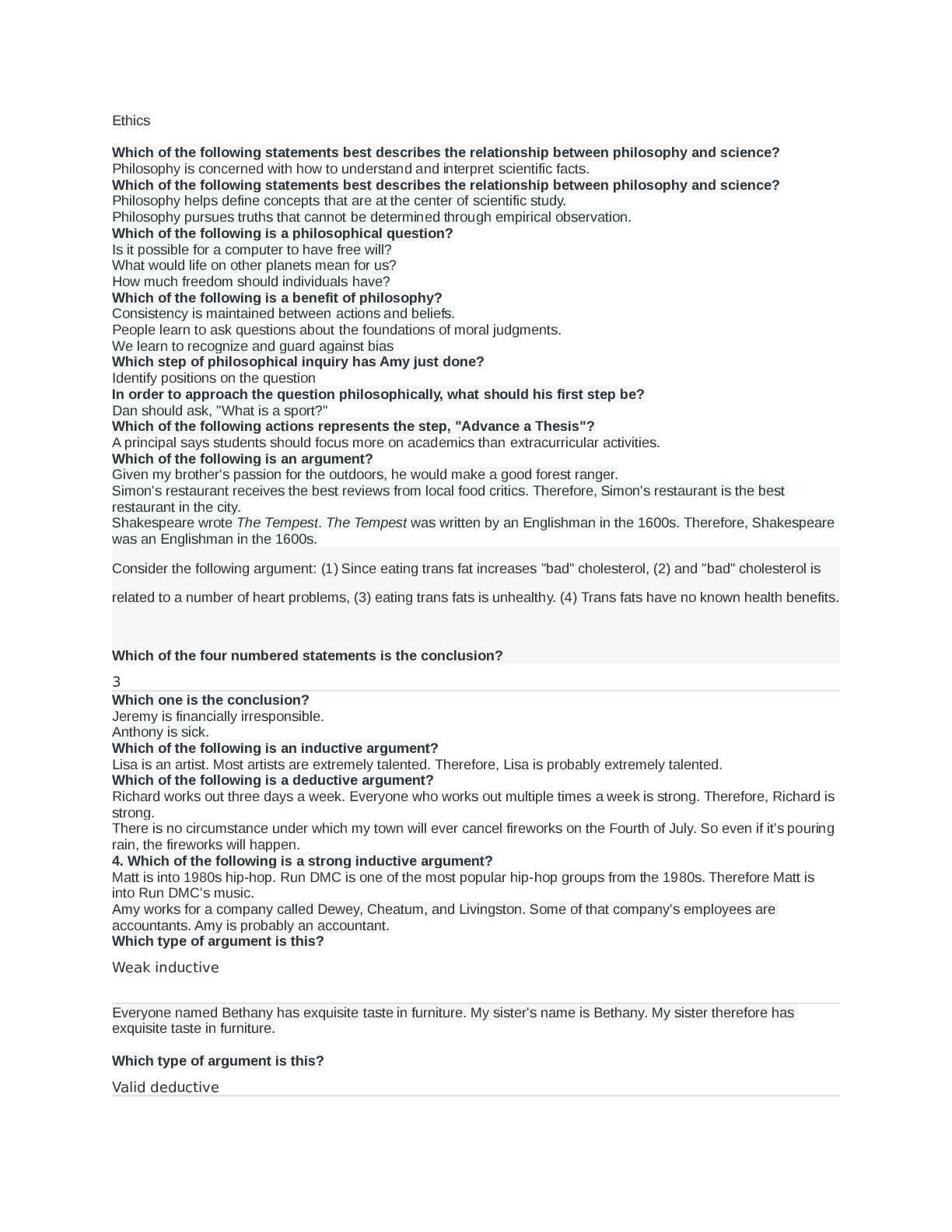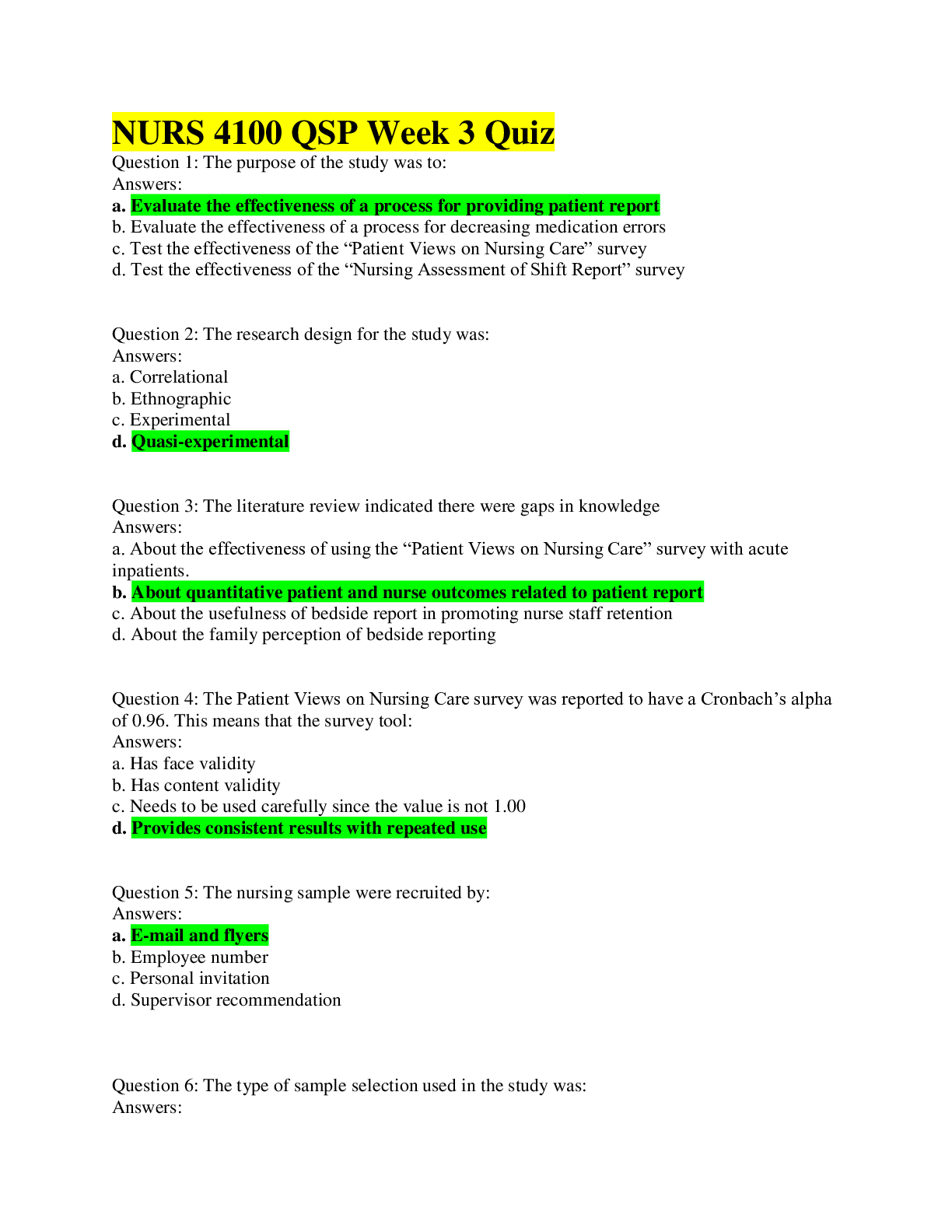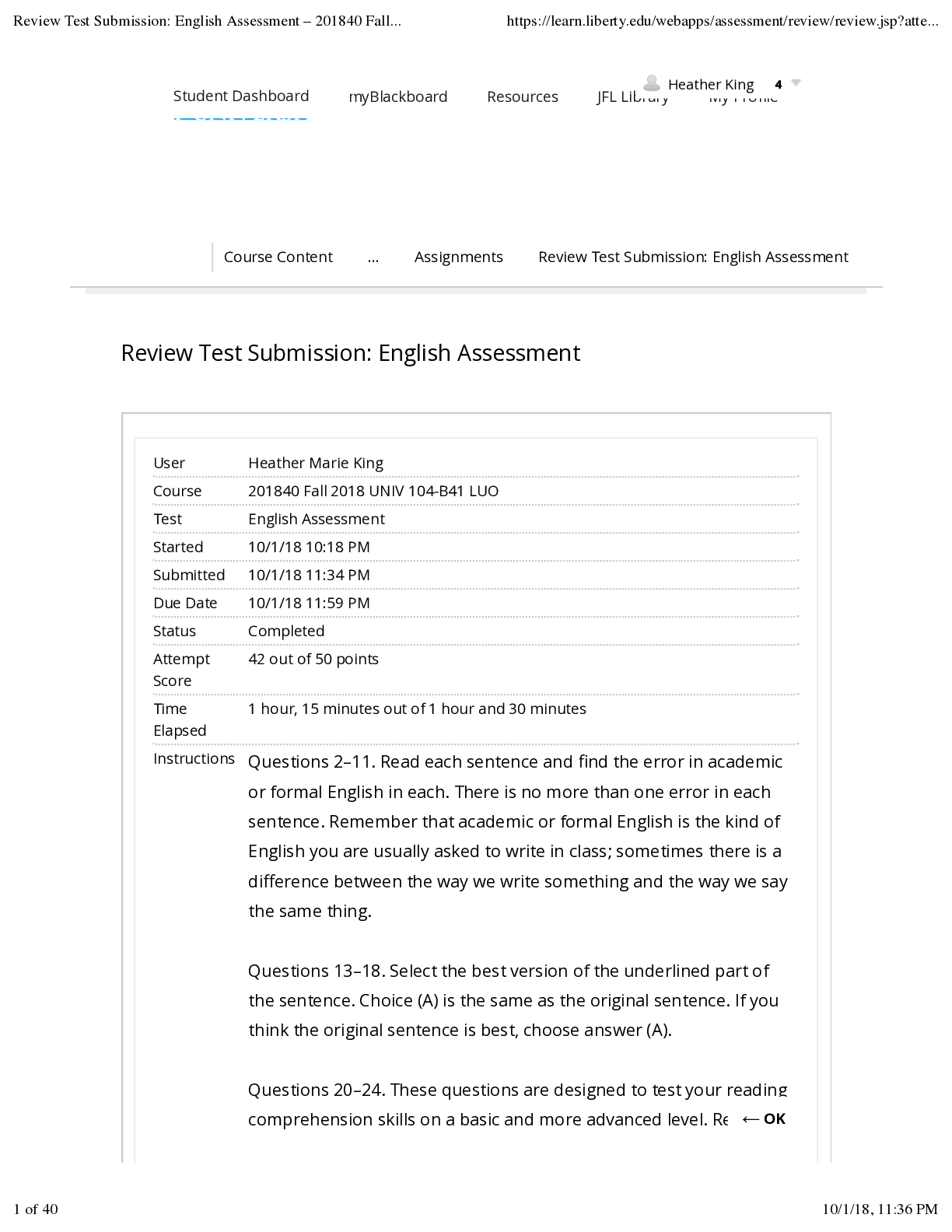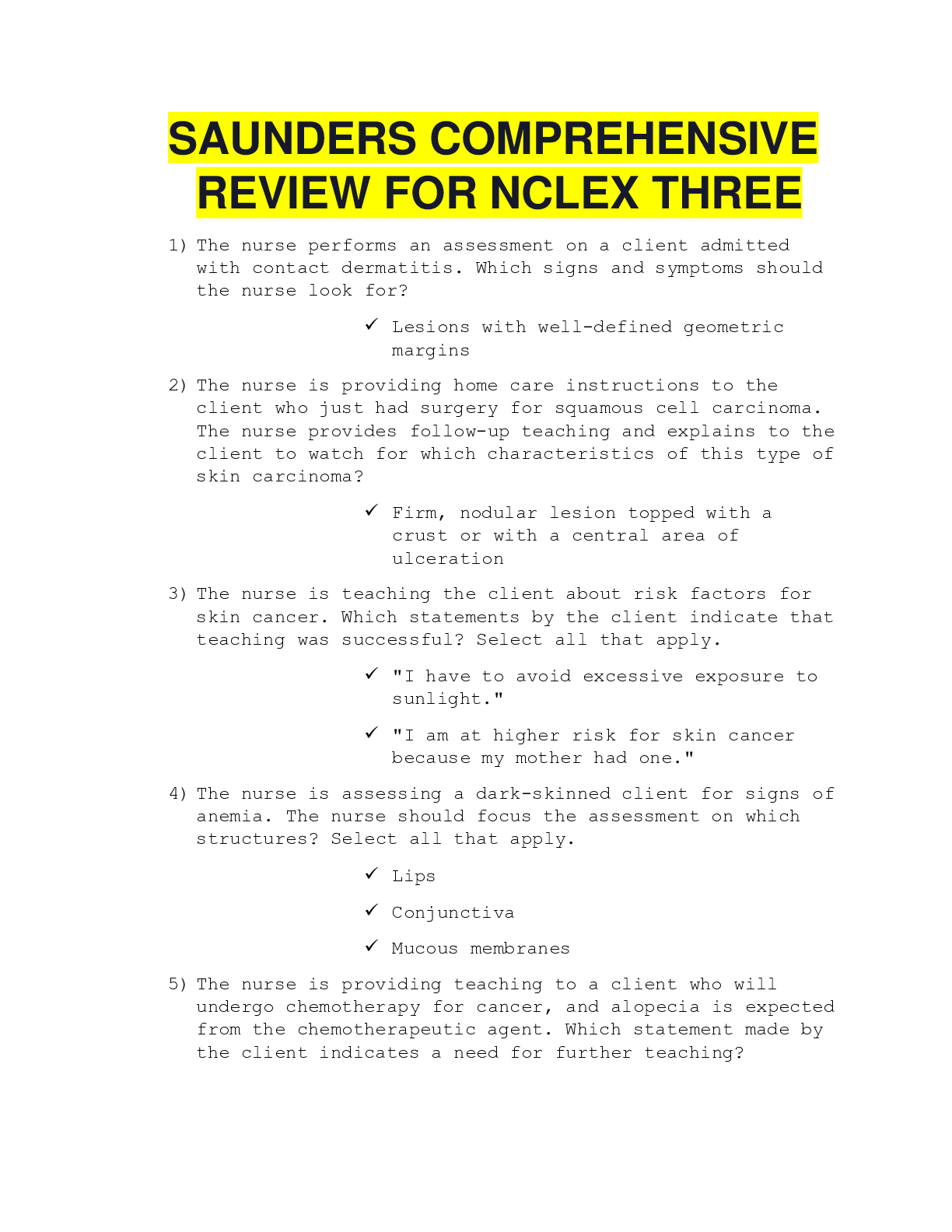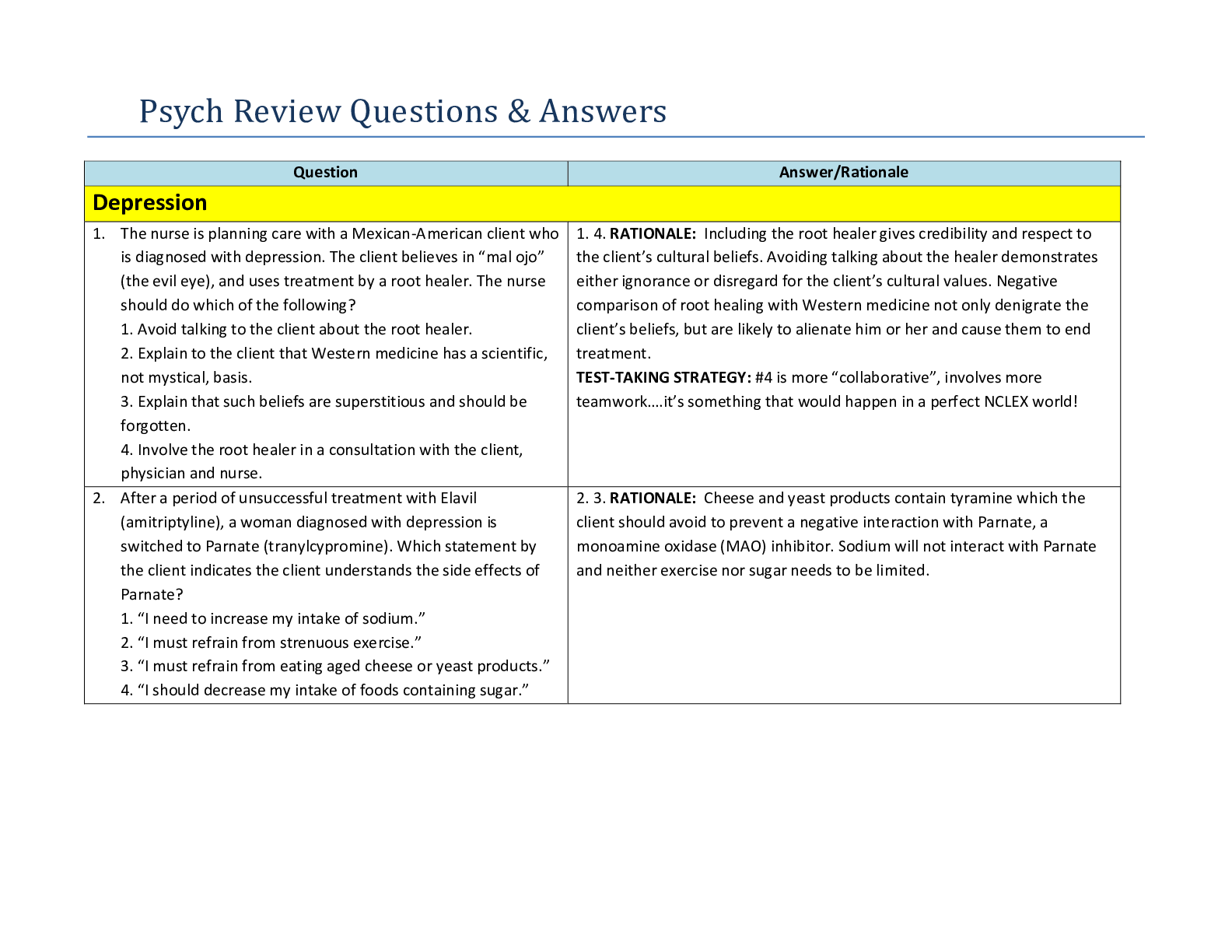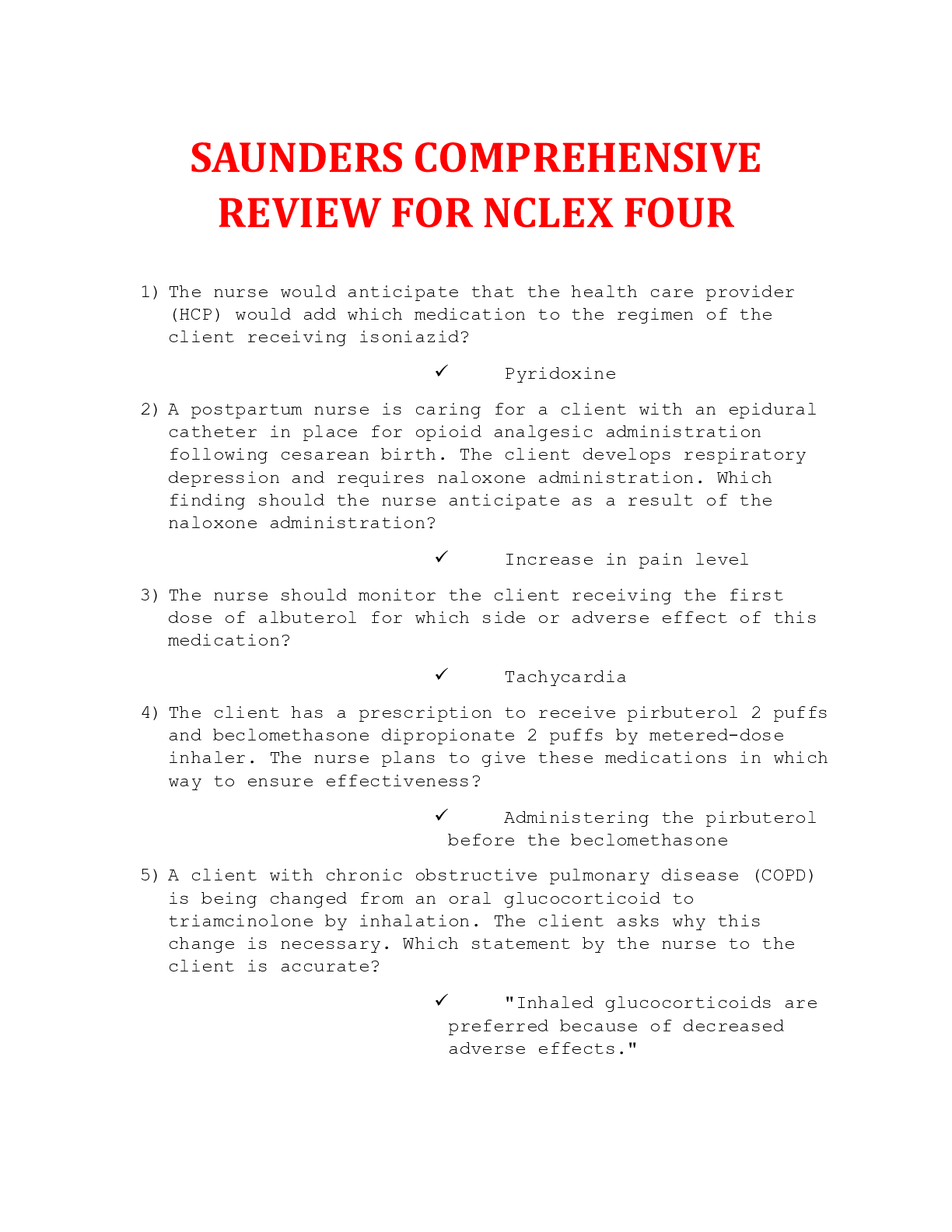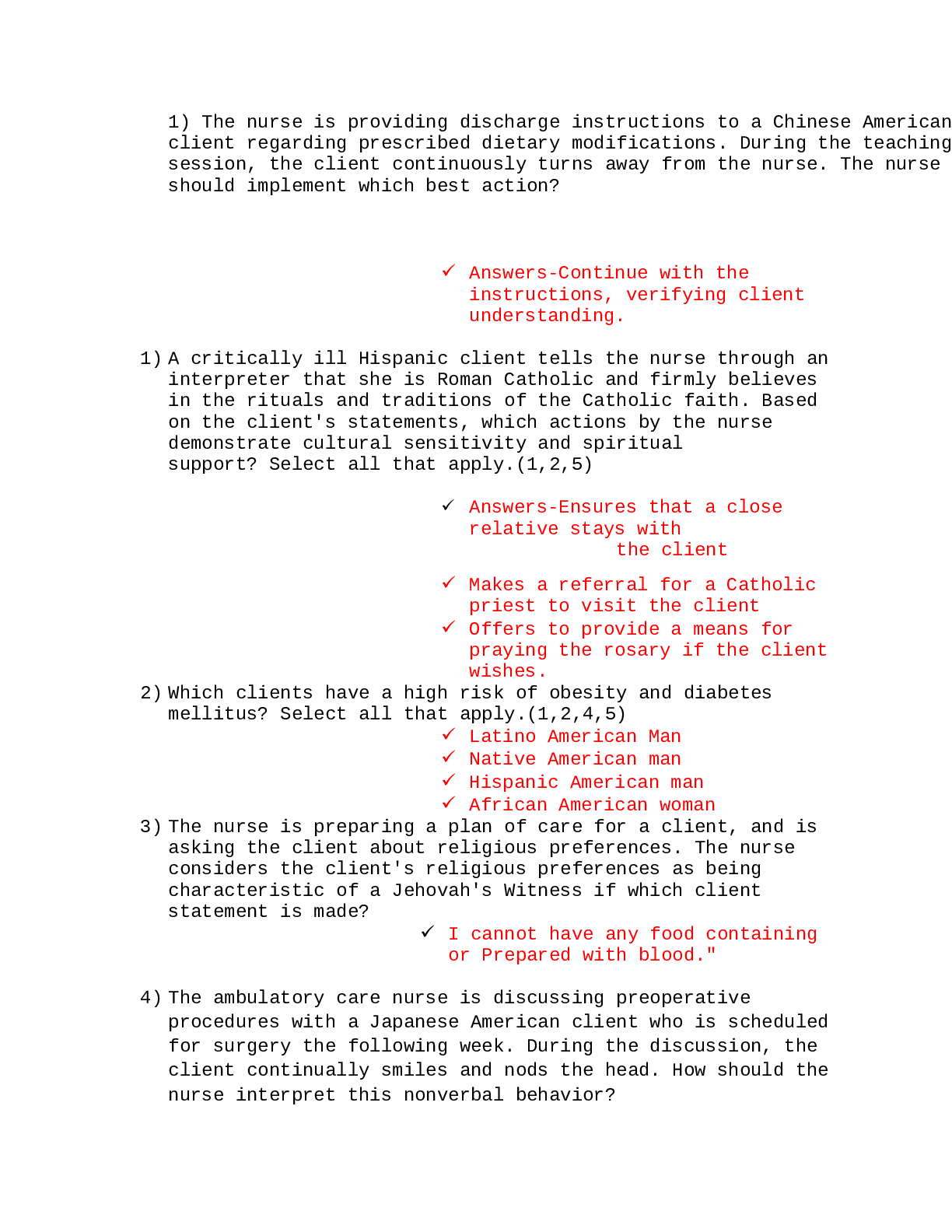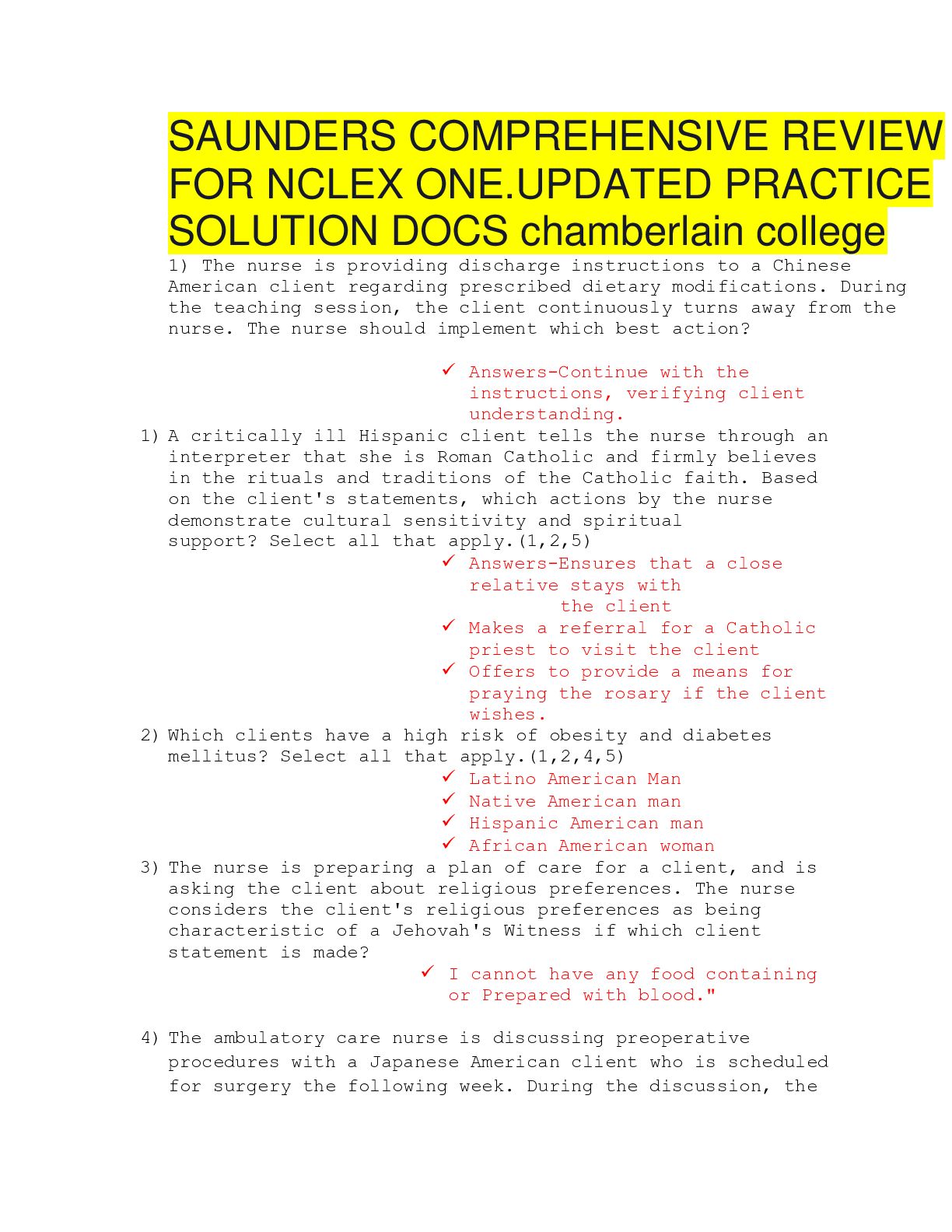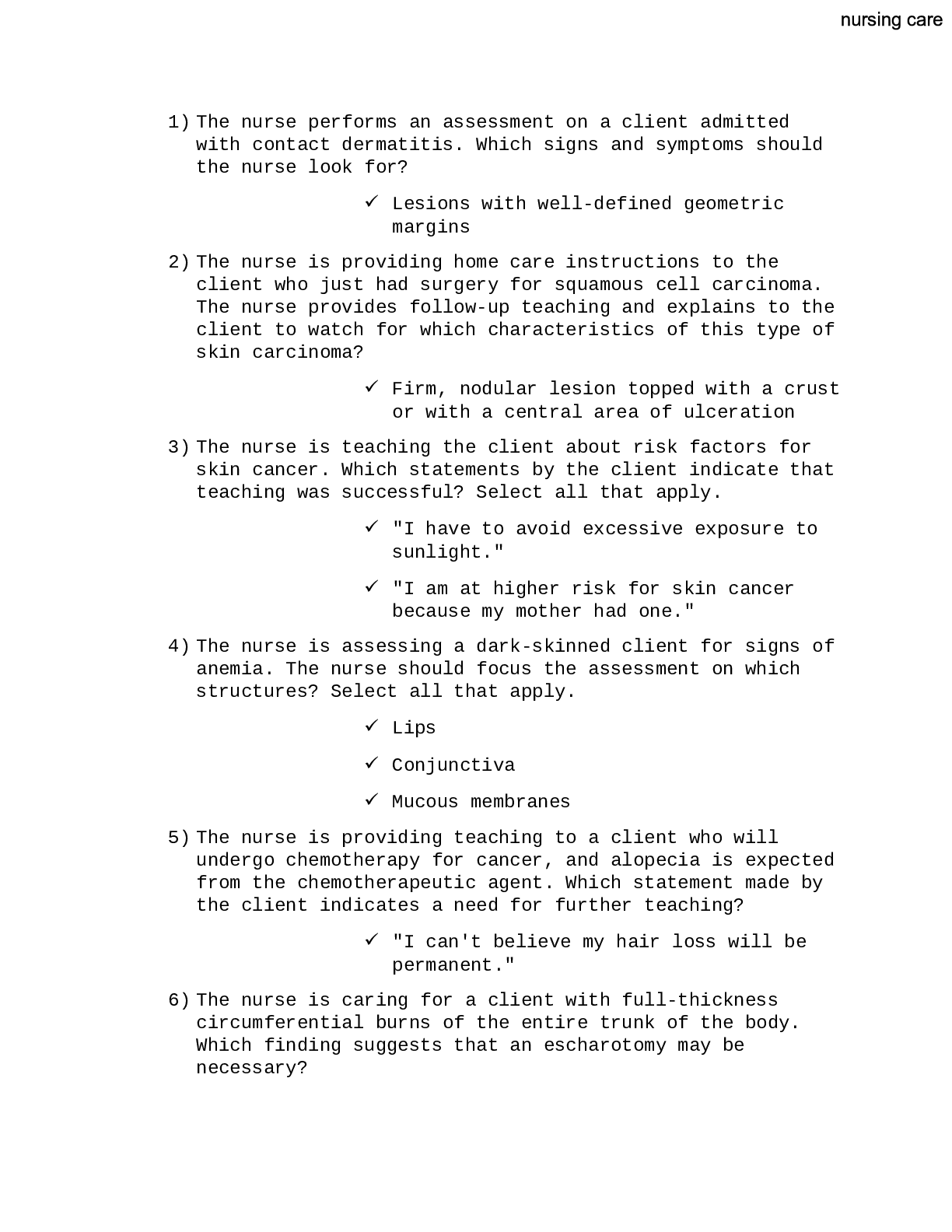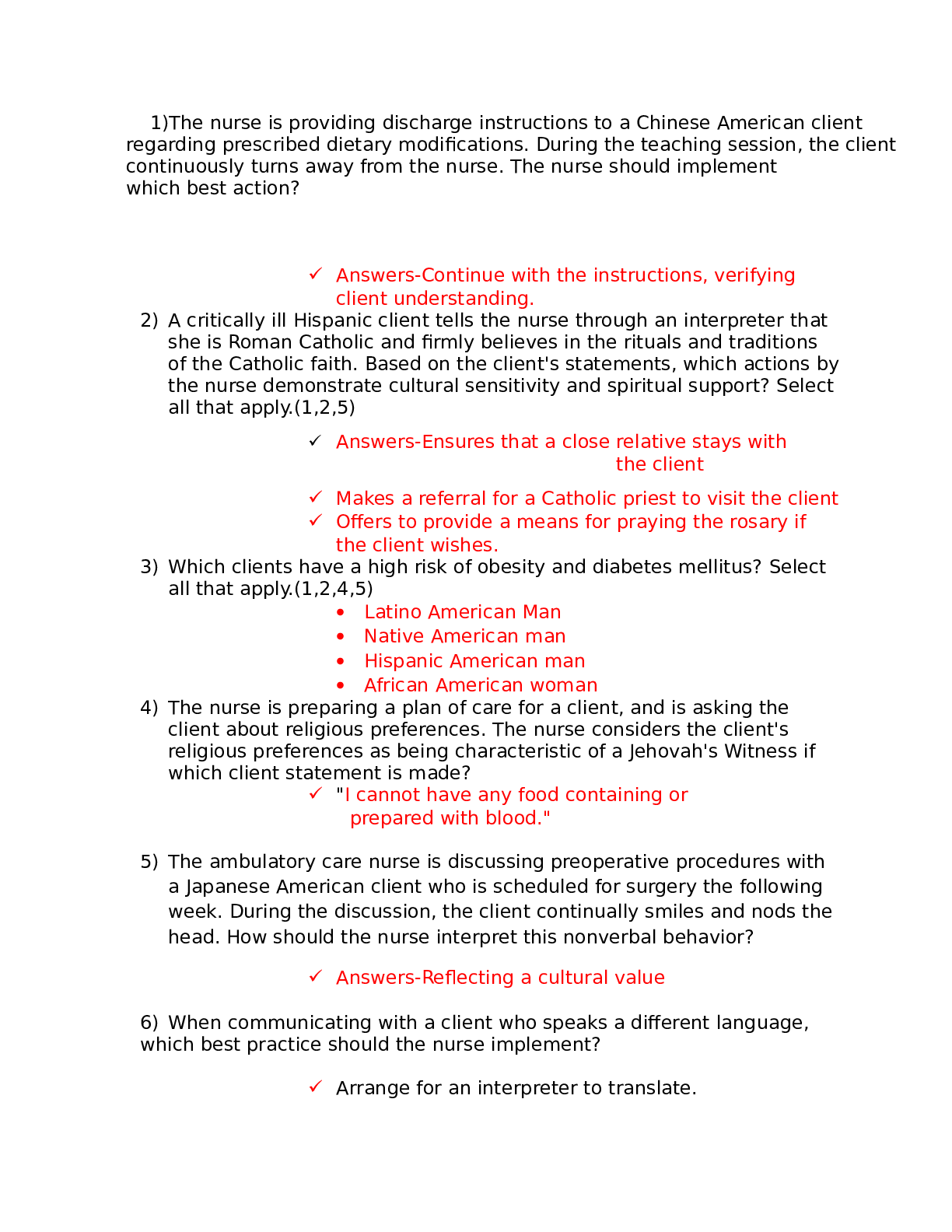*NURSING > QUESTIONS & ANSWERS > SAUNDERS COMPREHENSIVE REVIEW FOR NCLEX FOUR (Latest & revised Testbank) 1141 questions & complete a (All)
SAUNDERS COMPREHENSIVE REVIEW FOR NCLEX FOUR (Latest & revised Testbank) 1141 questions & complete answers.
Document Content and Description Below
SAUNDERS COMPREHENSIVE REVIEW FOR NCLEX FOUR 1) The nurse would anticipate that the health care provider (HCP) would add which medication to the regimen of the client receiving isoniazid? Pyrido... xine 2) A postpartum nurse is caring for a client with an epidural catheter in place for opioid analgesic administration following cesarean birth. The client develops respiratory depression and requires naloxone administration. Which finding should the nurse anticipate as a result of the naloxone administration? Increase in pain level 3) The nurse should monitor the client receiving the first dose of albuterol for which side or adverse effect of this medication? Tachycardia 4) The client has a prescription to receive pirbuterol 2 puffs and beclomethasone dipropionate 2 puffs by metered-dose inhaler. The nurse plans to give these medications in which way to ensure effectiveness? Administering the pirbuterol before the beclomethasone 5) A client with chronic obstructive pulmonary disease (COPD) is being changed from an oral glucocorticoid to triamcinolone by inhalation. The client asks why this change is necessary. Which statement by the nurse to the client is accurate? "Inhaled glucocorticoids are preferred because of decreased adverse effects." 6) A client taking theophylline has a serum theophylline level of 15 mcg/mL (60 mcmol/L). How does the nurse interpret this laboratory value? In the middle of the therapeutic range 7) A client is taking cetirizine. The nurse should inform the client of which side effect of this medication? Drowsiness 8) A client is scheduled to receive acetylcysteine 20% solution diluted in 0.9% normal saline by nebulizer. Which outcome would the nurse expect as a result of the administration of this medication? Thinning of respiratory secretions 9) The health care provider prescribes cromolyn for the client with asthma. The nurse identifies that the client correctly understands the purpose of this medication when the client states that the medication will produce which effect? 10) The nurse is teaching a client about the effects of diphenhydramine, an ingredient in the cough suppressant prescribed for the client. The nurse should plan to tell the client to take which measure while taking this medication? Avoid activities requiring mental alertness. 11) The health care provider (HCP) has prescribed codeine sulfate for a client with a nonproductive cough to suppress the cough reflex. The nurse should teach the client to monitor for which side effect of the medication? Constipation 12) A client has begun therapy with a xanthine bronchodilator. The nurse determines that the client understands dietary alterations if the client states to limit which items while taking this medication? Select all that apply. Coffee Chocolate 13) Which supplies should the nurse obtain for the administration of ribavirin to a hospitalized child with respiratory syncytial virus (RSV)? A mask and pair of goggles 14) The nurse is documenting information in a client's chart when the electrocardiogram telemetry alarm sounds, and the nurse notes that the client is in ventricular tachycardia (VT). The nurse rushes to the client's bedside and should perform which assessment first? Check responsiveness 15) A client is brought into the emergency department in ventricular fibrillation (VF). The nurse prepares to defibrillate by placing defibrillation pads on which part of the chest? To the right of the sternum and to the left of the precordium 16) An adult client has been unsuccessfully defibrillated for ventricular fibrillation, and cardiopulmonary resuscitation (CPR) is resumed. The nurse confirms that CPR is being administered effectively by noting which action The carotid pulse is palpable with each compression. 17) The nurse is assigned the care of a client who experienced a myocardial infarction and is being monitored by cardiac telemetry. The nurse notes the sudden onset of this cardiac rhythm on the monitor. The nurse should immediately take which action? Refer to Figure. View Figure Initiate cardiopulmonary resuscitation (CPR). 18) To perform defibrillation, the defibrillator pads should be placed in which areas of the client's chest? To the right of the sternum just below the clavicle and to the left side, just below and to the left of the pectoral muscle 19) The nurse is caring for a client who is pulseless and experiencing this dysrhythmia. Which interventions should the nurse anticipate implementing in collaboration with the health care provider (HCP)? Select all that apply. Refer to Figure. View Figure Prepare to administer amiodarone. Prepare to administer epinephrine. Provide cardiopulmonary resuscitation (CPR). 20) The nurse is performing cardiopulmonary resuscitation (CPR) on a client who has had a cardiac arrest. An automatic external defibrillator (AED) is available to treat the client. Which activity will allow the nurse to assess the client's cardiac rhythm? Apply adhesive patch electrodes to the chest and move away from the client. 21) The nurse is teaching adult cardiopulmonary resuscitation (CPR) guidelines to a group of laypeople. The nurse observes the group correctly demonstrate 2-rescuer CPR when which ratio of compressions to ventilations is performed on the mannequin? 30:2 22) The nurse is teaching cardiopulmonary resuscitation (CPR) to a group of community members. The nurse tells the group that when chest compressions are performed on infants, the sternum should be depressed how far? About 1½ inches (4 cm) 23) The nursing instructor teaches a group of students about cardiopulmonary resuscitation. The instructor asks a student to identify the most appropriate location at which to assess the pulse of an infant younger than 1 year of age. Which response would indicate that the student understands the appropriate assessment procedure? Brachial artery 24) The nurse is conducting a basic life support (BLS) recertification class and is discussing chest compressions in a pregnant woman. The nurse should tell the class that which action should be taken in an advanced pregnancy client whose fundal height is at or above the umbilicus? Maintain manual left uterine displacement during compressions. 25) The nurse is initiating 1-rescuer cardiopulmonary resuscitation on an adult client. The nurse should place the hands in which position to begin chest compressions? On the lower half of the sternum 26) The nurse walking in a downtown business area witnesses a worker fall from a ladder. The nurse rushes to the victim, who is unresponsive. A layperson is attempting to perform resuscitative measures. The nurse should intervene if which action by the layperson is noted? Use of the head tilt–chin lift 27) The nurse notes that a 14-year-old child is choking but is awake and alert at this time. The nurse rushes to perform the abdominal thrust maneuver. The child becomes unconscious. What procedure should the nurse perform next? Start chest compressions. 28) The nurse assigned to the pediatric unit finds an infant unresponsive and without respirations or a pulse. What is the nurse's next action after calling for help? Perform compressions at 100 to 120 times per minute. 29) The nurse is undergoing annual recertification in basic life support (BLS). The BLS instructor asks the nurse to identify the pulse point to use when determining pulselessness on an infant. Which response by the nurse identifies the most appropriate pulse point? Brachial 30) External public access defibrillator (PAD) interprets that the rhythm of a pulseless victim is ventricular fibrillation and advises defibrillation. Which action should the rescuer take next? Order people away from the client, charge the machine, and depress the discharge buttons. 31) Cardiopulmonary resuscitation (CPR) is immediately initiated on a client who is unconscious and has no pulse. A monitor is attached and it is determined that the rhythm is shockable, and defibrillation with 1 shock is delivered. Which action should the nurse plan to take next? Perform CPR for 5 cycles, and then defibrillate again if the rhythm is shockable. 32) The nurse has completed 5 cycles of compressions after beginning cardiopulmonary resuscitation (CPR) on a hospitalized adult client who experienced unmonitored cardiac arrest. What should the nurse plan to do next? Charge the defibrillator. 33) The nurse is teaching chest compressions for cardiopulmonary resuscitation (CPR) to a group of lay clients. Which behavior by one of the participants indicates a need for further teaching? Letting the right and left fingers rest on the chest 34) In order of priority, how should the nurse perform abdominal thrusts on an unconscious adult? Arrange the actions in the order that they should be performed. All options must be used. 1,2,3,4,5 35) One unit of packed red blood cells has been prescribed for a client with severe anemia. The client has received multiple transfusions in the past, and it is documented that the client has experienced urticaria-type reactions from the transfusions. The nurse anticipates that which medication will be prescribed before administration of the red blood cells to prevent this type of reaction? Diphenhydramine 36) The nurse has a prescription to administer whole blood to a client who does not currently have an intravenous (IV) line inserted. When obtaining supplies to start the blood infusion, the nurse should select an angiocatheter of at least which size? 19 gauge 37) A client has experienced high blood pressure and crackles in the lungs during previous blood transfusions. The client asks the nurse whether it is safe to receive another transfusion. The nurse explains that which medication most likely will be prescribed before the transfusion is begun? Furosemide 38) The nurse is told by a health care provider that a client in hypovolemic shock will require plasma expansion. The nurse should prepare which supplies for transfusion? Bottle of albumin with vented tubing 39) The nurse has discontinued a unit of blood that was infusing into a client because the client experienced a transfusion reaction. After documenting the incident appropriately, the nurse sends the blood bag and tubing to which department? Blood bank 40) The nurse has just obtained a unit of blood from the blood bank to transfuse into a client as prescribed. Before preparing the blood for transfusion, the nurse looks for which member of the health care team to assist in checking the unit of blood? Registered nurse (RN) 41) The nurse is picking up a unit of packed red blood cells at the hospital blood bank. After putting the pen down, the nurse glances at the clock, which reads 1300. The nurse calculates that the transfusion must be started by which time? 1330 42) The nurse enters a client's room to assess the client, who began receiving a blood transfusion 45 minutes earlier, and notes that the client is flushed and dyspneic. On assessment, the nurse auscultates the presence of crackles in the lung bases. The nurse determines that this client most likely is experiencing which complication of blood transfusion therapy? Circulatory overload 43) The nurse is monitoring a client who is receiving a blood transfusion. After 30 minutes of the infusion, the client begins to have chills and back pain. His temperature is 100.1°F (37.8°C). What action should the nurse take first? Discontinue the infusion and start an infusion of normal saline using new tubing. 44) The nurse enters the room of a client who began receiving a blood transfusion 45 minutes earlier to check on the client. The client is complaining of "itching all over" and has a generalized rash. The client's temperature has not changed from baseline and the lungs are clear to auscultation. Which complication of blood transfusion therapy should the nurse determine that this client is most likely experiencing? Allergic transfusion reaction 45) A unit of platelets was just received from the blood bank for transfusion to an assigned client. The nurse should select tubing with which feature for the transfusion? An in-line filter 46) The nurse overhears a health care provider (HCP) stating that a client diagnosed with disseminated intravascular coagulation (DIC) requires a transfusion. Which blood product should the nurse anticipate that the HCP will write a prescription for? Cryoprecipitate 47) The nurse is assisting in monitoring a client who is receiving a transfusion of packed red blood cells (PRBCs). Before leaving the room, the nurse tells the client to immediately report which symptoms of a transfusion reaction? Select all that apply. Chills Chest pain Lower back pain Difficulty breathing 48) A child is receiving succimer for the treatment of lead poisoning. The nurse should monitor which most important laboratory result? Blood urea nitrogen level 49) A client with a probable minor head injury resulting from a motor vehicle crash is admitted to the hospital for observation. The nurse leaves the cervical collar applied to the client in place until when? The results of spinal radiography are known 50) A client experienced an open pneumothorax (sucking wound), which has been covered with an occlusive dressing. The client begins to experience severe dyspnea, and the blood pressure begins to fall. The nurse should first perform which action? Remove the dressing. 51) The nurse is performing an assessment on a client admitted to the nursing unit who has sustained an extensive burn injury involving 45% of total body surface area. When planning for fluid resuscitation, the nurse should consider that fluid shifting to the interstitial spaces is greatest during which time period? Between 18 and 24 hours after the injury 52) The nurse in the recovery room is caring for a client who underwent neurosurgery. Sequential compression devices (SCDs) have been applied to prevent venous stasis. While awaiting client transfer to the intensive care unit, the recovery room nurse should perform which critical assessment? Monitor vascular status of the lower extremities. 53) A pulmonary artery catheter is inserted into a client during cardiac surgery. The nurse is monitoring the right atrial pressure (RAP). Which finding requires immediate nursing intervention? 12 mm Hg 54) The nursing educator has just completed a lecture to a group of nurses regarding care of the client with a burn injury. A major aspect of the lecture was care of the client at the scene of a fire. Which statement, if made by a nurse, indicates a need for further instruction? "The client should be maintained in a standing position." 55) The community health nurse is providing a teaching session to firefighters in a small community regarding care of a burn victim at the scene of injury. The nurse instructs the firefighters that in the event of a tar burn, which is the immediate action? Cooling the injury with water 56) The industrial nurse is providing instructions to a group of employees regarding care to a client in the event of a chemical burn injury. The nurse instructs the employees that which is the first consideration in immediate care? Removing all clothing, including gloves, shoes, and any undergarments 57) A client who sustained an inhalation injury arrives in the emergency department. On initial assessment, the nurse notes that the client is very confused and combative. The nurse determines that the client is most likely experiencing which condition? Hypoxia 58) A client is brought to the emergency department immediately after a smoke inhalation injury. The nurse initially prepares the client for which treatment? 100% humidified oxygen by face mask 59) The nurse is caring for a client who sustained a burn injury to the anterior arms and anterior chest area from a fire. Which assessment finding would indicate that the client sustained a respiratory injury as a result of the burn? Use of accessory muscles for breathing 60) The nurse is performing an assessment on a client who sustained circumferential burns of both legs. Which assessment would be the initial priority in caring for this client? Assessing peripheral pulses 61) The nurse is developing a plan of care for a client who sustained an inhalation burn injury. Which nursing intervention should the nurse include in the plan of care for this client? Elevate the head of the bed. 62) The nurse has developed a nursing care plan for a client with a burn injury to implement during the emergent phase. Which priority intervention should the nurse include in the plan of care? Monitor mental status every hour. 63) The nurse is developing a nursing care plan for a client with a circumferential burn injury of the right arm. What is the nurse's priority action? Monitor the radial pulse every hour. 64) Vasopressin is prescribed for a client with a diagnosis of bleeding esophageal varices. The nurse should prepare to administer this medication by which route? By intravenous infusion 65) Vasopressin therapy is prescribed for a client with a diagnosis of bleeding esophageal varices. The nurse is preparing to administer the medication to the client. Which essential item is needed during the administration of this medication? A cardiac monitor 66) The nurse is monitoring a client who required a Sengstaken-Blakemore tube because other measures for treating bleeding esophageal varices were unsuccessful. The client complains of severe pain of abrupt onset. Which nursing action is most appropriate? Cut the tube. 67) A postpartum client who received an epidural analgesic after giving birth by cesarean section is lethargic and has a respiratory rate of 8 breaths per minute. The nurse should obtain which medication from the emergency cart after notifying the health care provider? Naloxone 68) The nurse is reviewing the medical record of a client transferred to the medical unit from the critical care unit. The nurse notes that the client received intra-aortic balloon pump (IABP) therapy while in the critical care unit. The nurse suspects that the client received this therapy for which condition? Cardiogenic shock 69) The nurse is providing care for a client who sustained burns over 30% of the body from a fire. On assessment, the nurse notes that the client is edematous in both burned and unburned body areas. The client's wife asks why her husband "looks so swollen." What is the nurse's best response? "Leaking blood vessels have led to decreased protein amounts in the blood." 70) The emergency department nurse is monitoring a client who received treatment for a severe asthma attack. The nurse determines that the client's respiratory status has worsened if which is noted on assessment? Diminished breath sounds 71) The nurse is performing an assessment on a client who was admitted with a diagnosis of carbon monoxide poisoning. Which assessment performed by the nurse would primarily elicit data related to a deterioration of the client's condition? Level of consciousness 72) The nurse is reviewing the laboratory test results for a client admitted to the burn unit 3 hours after an explosion that occurred at a worksite. The client has a severe burn injury that covers 35% of the total body surface area (TBSA). The nurse is most likely to note which finding on the laboratory report? Hematocrit 60% (0.60) 73) The nurse is caring for a client who sustained a thermal burn caused by the inhalation of steam 24 hours ago. The nurse determines that the priority nursing action is to assess which item? Lung sounds 74) A client with depression receiving phenelzine sulfate suddenly complains of a severe headache and neck stiffness and soreness and then begins to vomit. The nurse takes the client's blood pressure and notes that it is 210/102 mm Hg. On the basis of the findings, the nurse should obtain which medication from the emergency drawer of the medication cart? Phentolamine 75) Acetylcysteine is prescribed for a client in the hospital emergency department after diagnosis of acetaminophen overdose. The nurse prepares to administer the medication using which procedure? Diluting the medication in cola and administering it to the client orally 76) A pregnant client being admitted to the labor room tells the nurse that she felt a large gush of fluid before arriving at the hospital. The nurse performs an assessment on the client and notes that the fetal heart rate is 90 beats/minute and that the umbilical cord is protruding from the vagina. What is the appropriate nursing action? Wrap the cord loosely in a sterile towel saturated with warm, sterile normal saline. 77) The nurse receives a telephone call from a neighbor, who states that her 3-year-old child was found sitting on the kitchen floor with an empty bottle of liquid furniture polish. The mother of the child tells the nurse that the bottle was half full, that the child's breath smells like the polish, and that spilled polish is present on the front of the child's shirt. What should the nurse tell the mother to do first? Call the Poison Control Center. 78) The nurse is caring for a client who sustained multiple fractures in a motor vehicle crash 12 hours earlier. The client now exhibits severe dyspnea, tachycardia, and mental confusion, and the nurse suspects fat embolism. Which is the initial nursing action? Position the client in a Fowler's position. 79) The home health nurse is visiting an older client whose family has gone out for the day. During the visit, the client experiences chest pain that is unrelieved by sublingual nitroglycerin tablets given by the nurse. Which action by the nurse would be appropriate at this time? Call for an ambulance to transport the client to the hospital emergency department. 80) The client who has experienced a myocardial infarction (MI) is recovering from cardiogenic shock. The nurse knows that which observation of the client's clinical condition is most favorable? Urine output of 40 mL/hr 81) A client in cardiogenic shock has a pulmonary artery catheter (Swan-Ganz type) placed. The nurse would interpret which cardiac output (CO) and pulmonary capillary wedge pressure (PCWP) readings as indicating that the client is most unstable? CO 3 L/min, PCWP high 82) A client in cardiogenic shock had an intra-aortic balloon pump inserted 24 hours earlier via the left femoral approach. The nurse notes that the client's left foot is cool and mottled and the left pedal pulse is weak. Which action should the nurse take? Call the health care provider immediately. 83) The nurse is caring for a client with a chest tube drainage system. While the client is being assisted to sit up in bed in preparation for ambulation, the chest tube accidentally disconnects from the chest drainage system. Which is the initial nursing action? Place the end of the chest tube in a container of sterile water. 84) The nurse is caring for a client with a chest tube drainage system. During repositioning of the client, the chest tube accidentally pulls out of the pleural cavity. Which is the initial nursing action? Apply an occlusive dressing. 85) The nurse reviewing the operative record for a client who has just undergone cardiac surgery notes that the client's cardiac output immediately after surgery was 3.6 L/min. Which intervention is appropriate based on the client's cardiac output reading? Notify the health care provider (HCP). 86) The nurse has a prescription to administer acetylcysteine to a client admitted to the emergency department with acetaminophen overdose. Before giving this medication, what is the nurse's best action? Empty the stomach by emesis or lavage. 87) A client with a history of gastric ulcer complains of a sudden, sharp, severe pain in the midepigastric area, which then spreads over the entire abdomen. The client's abdomen is rigid and boardlike on palpation, and the client obtains most comfort from lying in the knee-chest position. The nurse suspects which condition and should perform which action? Perforation; notify the health care provider. 88) A postoperative client receives a dose of naloxone hydrochloride for respiratory depression shortly after transfer to the nursing unit from the postanesthesia care unit. After administration of the medication, the nurse should assess the client for which change? Sudden increase in pain 89) A new nursing graduate is caring for a client who is attached to a cardiac monitor. While assisting the client with bathing, the nurse observes the sudden development of ventricular tachycardia (VT), but the client remains alert and oriented and has a pulse. Which interventions would the nurse take? Select all that apply. Administer oxygen. Obtain an electrocardiogram (ECG). Contact the health care provider (HCP). Assess circulation, airway, and breathing. 90) An emergency department nurse is caring for a child with suspected acute epiglottitis. Which nursing interventions apply in the care of this child? Select all that apply. Ensure a patent airway. Obtain a pediatric-size tracheostomy tray. Prepare the child for a chest radiographic study. Place the child on an oxygen saturation monitor. 91) A client with a left arm fracture supported in a cast complains of loss of sensation in the left fingers. The nursing assessment identifies pallor in the distal portion of the arm, poor capillary refill, and a diminished left radial pulse. On the basis of these findings, the nurse would take which as a priority action? Contact the health care provider (HCP). 92) The nurse is caring for a client who is receiving feedings by nasogastric tube. The client suddenly begins to vomit, and the nurse quickly repositions the client. The client is coughing and having difficulty breathing. What is the nurse's priority action? Suction the client. 93) A delivery room nurse is caring for a client in labor. The client tells the nurse that she feels that something is coming through the vagina. The nurse performs an assessment and notes the presence of the umbilical cord protruding from the vagina. The nurse should immediately place the client in which position? On the side 94) The nurse witnesses an accident whereby a pedestrian is hit by an automobile. The nurse stops at the scene and assesses the victim. The nurse notes that the victim is responsive and has suffered trauma to the thorax resulting in a flail chest involving at least 3 ribs. What is the nurse's priority action for this victim? Apply firm but gentle pressure with the hands to the flail segment. 95) The nurse is assessing a client hospitalized with acute pericarditis. The nurse monitors the client for cardiac tamponade, knowing that which signs are associated with this complication of pericarditis? Select all that apply. Pulsus paradoxus Distant heart sounds Falling blood pressure (BP) Distended jugular veins 96) A client has frequent runs of ventricular tachycardia. The health care provider has prescribed flecainide. What is the best nursing action related to the effects of this medication while the client is hospitalized? Monitor vital signs and cardiac rhythm frequently. 97) A postpartum client with femoral thrombophlebitis has developed sudden shortness of breath and appears very anxious. What is the nurse's priority action for this client? Administer oxygen by face mask as per protocol at 8 to 10 L/min. 98) The child with croup is being discharged from the hospital. The nurse provides instructions to the mother and advises the mother to bring the child to the emergency department if which occurs? The child develops stridor. 99) The occupational health nurse is called to care for an employee who experienced a traumatic amputation of a finger. Which actions should the nurse take to provide emergency care and prepare the client for transport to the hospital? Select all that apply. Elevate the extremity above heart level. Assess the employee for airway or breathing problems. Examine the amputation site and apply direct pressure to the site using layers of gauze. 100) An emergency department nurse is caring for a conscious child who was brought to the emergency department after the ingestion of half a bottle of acetylsalicylic acid (aspirin). The nurse anticipates that which will be the initial treatment? The administration of an emetic [Show More]
Last updated: 1 year ago
Preview 1 out of 203 pages
Instant download

Buy this document to get the full access instantly
Instant Download Access after purchase
Add to cartInstant download
Reviews( 0 )
Document information
Connected school, study & course
About the document
Uploaded On
Apr 22, 2020
Number of pages
203
Written in
Additional information
This document has been written for:
Uploaded
Apr 22, 2020
Downloads
0
Views
127

.png)



